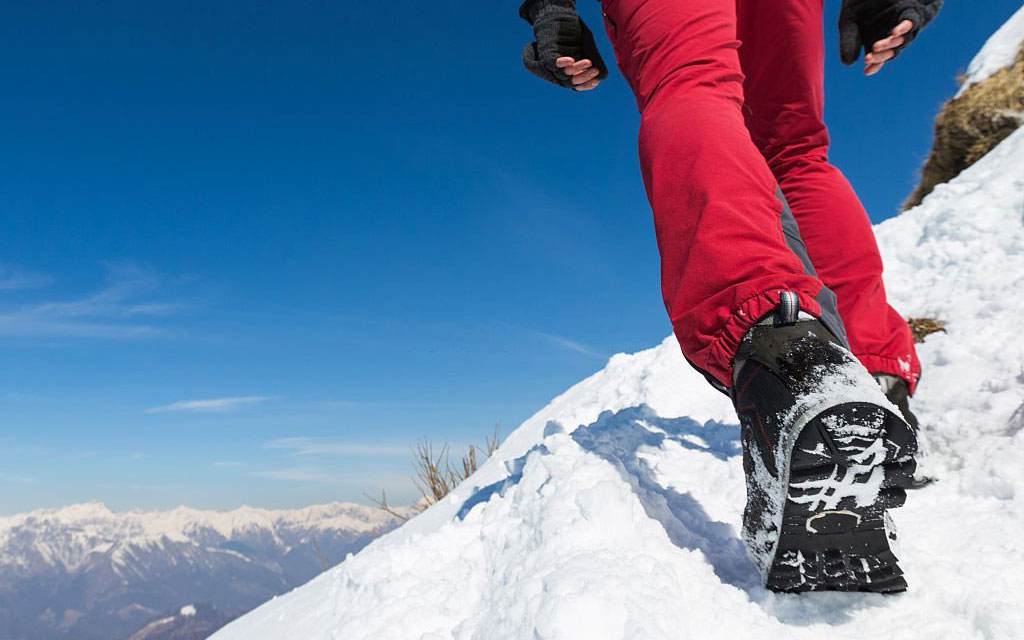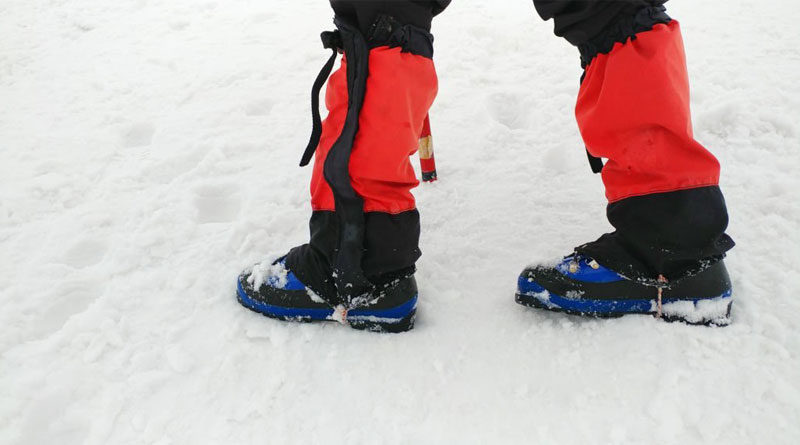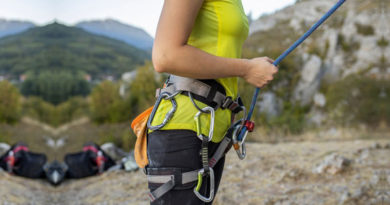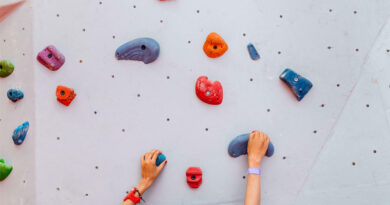Best Mountaineering Boots for Wide Feet of 2025
Mountaineering Boots are an essential piece of gear for any serious mountain climbing or mountaineering adventures. These boots are designed to provide comfort and support to your feet, while also offering the necessary protection and stability required for climbing in harsh, high-altitude environments. However, people with wider feet may have a difficult time finding the right fit because there are limited options available for them. So, I have compiled a list of top boots to help find the right fit for them. Some popular features of these boots include a wider fit, increased insulation, and a waterproof membrane to keep feet dry in wet conditions. With a pair of one of these, you can tackle any mountain with confidence and comfort.
1. Scarpa Ribelle HD
Weight (Pair): 3 lbs. 1 oz.
Waterproof: Yes, HDry
Footwear Height: Over-the-ankle
Crampon: Hybrid
Scarpa Ribelle HD Boots are a top choice for serious mountain climbers looking for high-performance boots that can handle the toughest conditions. These boots are intended for complex ice climbing as well as high-altitude mountaineering, and they provide great durability, comfort, and protection. The Ribelle HD has a waterproof and breathable material that keeps feet dry in rainy conditions, and insulation that adds warmth in cold weather. The outer sole is constructed of Vibram and provides exceptional traction even on the slickest terrain. The lacing mechanism on the boot is quick and simple to use, making it easy to acquire the correct fit, while the reinforced rand adds further protection against wear and punctures.
One of the standout features of the Scarpa Ribelle HD is its weight. Despite their tough design and heavy-duty construction, these boots are surprisingly light, making them an excellent choice for climbers who need to be quick on their feet. Because of its well-designed inner lining and footbed, the Scarpa Ribelle HD is also exceptionally comfortable, even when worn for extended periods of time. The Scarpa Ribelle HD Mountaineering Boots are a high-quality, high-performance option for climbers who require a boot that can withstand the most difficult situations. These boots will keep climbers safe and secure on their next climbing journey with their blend of durability, comfort, and protection.
What I like: A tough mountaineering boot that’s both lightweight and comfy on the trail.
What I don’t: Not super waterproof and is a little expensive.
See the Scarpa Ribelle HD See the Women’s Ribelle HD
2. La Sportiva Nepal Cube GTX
Weight (Pair): 4 lbs. 7.4 oz.
Waterproof: Yes, Gore-Tex
Footwear Height: Mid-calf
Crampon: Step-in
The La Sportiva Nepal Cube GTX mountaineering boots are a highly versatile and durable option for serious mountain climbers. These boots are designed with a wide last and a spacious toe box, making them a great choice for people with wider feet. With its sturdy design and waterproof and breathable Gore-Tex membrane, the Nepal Cube GTX keeps feet dry and comfortable over time. Technical climbing and ice climbing are made possible by the crampon-compatible design and outstanding traction and stability provided by the Vibram sole. In addition, the midsole of the boots is supportive and cushioned, making them cozy to wear for extended periods of time.
When choosing mountaineering boots for wide feet, it’s important to consider the width, volume, and shape of the toe box, as well as the support and stiffness of the sole. The Nepal Cube GTX ticks all of these boxes, making it an excellent choice for people with wider feet. The La Sportiva Nepal Cube GTX mountaineering boots are a high-quality option for people with wide feet who need durable and versatile boots for demanding mountain climbing. With their wide last and spacious toe box, these boots are sure to provide a comfortable and supportive fit, even during extended use.
What I like: Versatile, comfy, and lightweight than competing models.
What I don’t: It Absorbs water and becomes heavy.
See the La Sportiva Nepal Cube GTX See the Women’s Nepal Cube GTX
3. Scarpa Mont Blanc Pro GTX
Weight (Pair): 3 lbs. 15 oz.
Waterproof: Yes, Gore-Tex
Footwear Height: Mid-calf
Crampon: Step-in
The Scarpa Mont Blanc Pro GTX is a top-of-the-line option for serious mountain climbers who demand the best in terms of performance, comfort, and durability. Designed for the most demanding alpine and high-altitude environments, these boots are built to provide the stability, support, and protection needed for a successful climb. The Mont Blanc Pro GTX boots, with their waterproof and breathable Gore-Tex membrane, will keep your feet dry and comfortable even in the wettest and most strenuous conditions. The Vibram sole provides outstanding traction and stability, and the crampon-compatible construction makes tricky ice-climbing possible. The boots also include a supportive and cushioned midsole, which makes them easy to wear for long periods of time.
The Mont Blanc Pro GTX boots are built to last, using high-quality materials and cutting-edge technology to provide optimum protection and support. The lacing mechanism is simple and straightforward to use, and the boot has a roomy and comfortable fit that makes it suited for a wide range of foot shapes and sizes. Scarpa Mont Blanc Pro GTX mountaineering boots are an excellent choice for serious mountain climbers who demand the best in performance, comfort, and durability. These boots will provide the support and protection you need to succeed whether you are climbing a steep mountain or simply exploring difficult terrain.
What I like: More affordable and focused on performance than the La Sportiva Nepal Cube GTX mentioned above.
What I don’t: The fit can be too wide for some people.
See the Scarpa Mont Blanc Pro GTX See the Women’s Mont Blanc Pro GTX
4. Lowa Alpine Expert GTX
Weight (Pair): 3 lbs. 13.3 oz.
Waterproof: Yes, Gore-Tex
Footwear Height: Over-the-ankle
Crampon: Step-in
The Lowa Alpine Expert GTX is a top-performing and highly durable option for serious mountain climbers. These boots, which are made for the most difficult alpine terrain, offer the stability, support, and safety required for a successful climb. The Alpine Expert GTX boots are made with a waterproof and breathable Gore-Tex fabric, which will keep feet dry and comfortable even in the wettest and most demanding situations. Technical climbing and ice climbing are made possible by the crampon-compatible design and outstanding traction and stability provided by the Vibram sole. In addition, the midsole of the boots is supportive and cushioned, making them cozy to wear for extended periods.
The Alpine Expert GTX boots have a strong structure and are made with premium materials and cutting-edge technology to offer the highest level of support and protection. The boot is made with a roomy and comfortable wide fit and an intuitive, simple-to-use lacing system, making it appropriate for a variety of foot shapes and sizes. For serious mountaineers who need the best in performance, comfort, and durability, the Lowa Alpine Expert GTX climbing boots are a great option. These boots will give you the support and security you need to succeed, whether you’re scaling a steep mountain or simply exploring challenging terrain.
What I like: Does a good job in a variety of conditions, good lacing system
What I don’t: A little heavy and snow comes in the top
See the Lowa Alpine Expert GTX See the Women’s Alpine Expert GTX
5. La Sportiva Aequilibrium ST GTX
Weight (Pair): 2 lbs. 7 oz.
Waterproof: Yes, Gore-Tex
Footwear Height: Over-the-ankle
Crampon: Hybrid
The La Sportiva Aequilibrium ST GTX is a budget mountaineering boot built for multi-day adventures, glacier travel, and alpine climbs. The high-tenacity nylon Honey-Comb Guard uppers make them tough but keep the weight low. GORE-TEX® Performance Comfort linings provide waterproofing while allowing breathability, keeping feet dry and comfortable. Molded TPU heel and toe caps offer protection and work with semi-automatic crampons. TPU Mud Guards add abrasion resistance, increasing durability. The 3D Flex EVO system enhances ankle mobility with a directional flex joint for better support. Low-density PU midsoles and outsoles cushion well and adapt to rough terrain for better grip.
The Vibram® Mont rubber outsoles with Impact Brake System™ improve traction, wrapping up the sides for extra surface area. The Double Heel™ lug pattern boosts downhill braking and helps with smoother strides, reducing fatigue. Hybrid carbon-nylon weave insoles add extra support for technical routes. These boots feel solid and perform well in winter trekking and snowy conditions. The deep lugs clear debris effectively, and despite the support, they walk comfortably. The heel and midfoot fit well and the toe box feels roomy for wide feet. Though wider than most La Sportiva boots, the pointed front may be uncomfortable for some. A roomier toe box would make them perfect. They appear well-made, but durability over time is still unknown.
What I like: Excellent weather resistance for the price.
What I don’t: The lacing system looks very old school.
See the La Sportiva Aequilibrium ST GTX See the Women’s Aequilibrium ST GTX
6. Scarpa Phantom 6000

Weight (Pair): 4 lbs. 6 oz.
Waterproof: Yes, OutDry
Footwear Height: Mid-calf
Crampon: Hybrid
Scarpa Phantom 6000 is a lightweight full-featured double mountaineering boot on the market. A single boot is perfectly adequate for going out for a day or two, while double boots really have an advantage on multi-day excursions or expedition-style trips. That’s where you take out the inner boot and bring it into your tent with you. You can also put it inside your sleeping bag at night to help dry it, keep it warm, and keep it from freezing. A lot of people use it for ice climbing because it is a warm boot but more importantly, it is very lightweight for a double boot.
The boot features a Vibram sole that has deeper and shallower lugs to save weight. There’s a 360-degree helical tread, which increases traction on both ascending and descending and laterally as well. The boot also has a climbing zone up front and that will give you an increased surface area during rock climbing. Keep in mind that the sole isn’t as durable as some other traditional mountaineering boots. However, it is substantially lightweight. The Phantom 6000 is the lightest in its class and it weighs only 4 pounds 6 ounces for the pair (size 42).
What I like: Effective lacing system, technical fit, lightest double boot option
What I don’t: The wider fit in the heel and toe box may reduce the boot’s technical ability for people with narrow feet.
7. Scarpa Zodiac Tech GTX

Weight (Pair): 2 lbs. 11.8 oz.
Waterproof: Yes, OutDry
Footwear Height: Over-the-ankle
Crampon: Hybrid/strap-on
The Scarpa Zodiac Tech GTX is a stripped-down version that strikes a good balance between an approach shoe and a mountaineering boot. The Zodiac Tech GTX delivers excellent traction and stability, thanks to its Vibram outsole and rocker profile. The boot’s innovative design allows for quick and easy transitions between hiking and climbing, and the crampon-compatible sole provides added grip and stability on snow and ice. You get a Gore-Tex membrane with these boots that provides waterproof and breathable protection, helping to keep feet dry and comfortable in even the harshest conditions. The boot also features a comfortable fit, which makes it a suitable option for a variety of foot shapes and sizes.
The Gore-Tex membrane on these boots is very effective. It provides the best water protection with breathability even in the pouring rain. The Vibram outsole and rocker profile provide excellent traction and stability on various terrains. Additionally, the crampon-compatible sole ensures added grip and stability on snow and ice, making the Zodiac Tech GTX suitable for ice climbing and other alpine adventures. Overall, the Scarpa Zodiac Tech GTX is a top-performing mountaineering boot that is suitable for a wide range of alpine adventures. Whether you’re planning a multi-day trek in the mountains or an ice-climbing excursion, these boots will provide the support, comfort, and protection you need to tackle any terrain with confidence.
What I like: Durable construction, excellent protection, support, and grip for demanding mountaineering objectives.
What I don’t: Noticeably stiffer and less padded than most mountaineering boots.
See the Scarpa Zodiac Tech GTX See the Women’s Zodiac Tech GTX
8. La Sportiva G2 Evo

Weight (Pair): 4 lbs. 10 oz.
Waterproof: No
Footwear Height: Over-the-ankle
Crampon: Step-in
The La Sportiva G2 Evo is a high-performance double boot designed for extreme cold and high-altitude mountaineering. It builds on the success of the original G2, offering top-tier warmth and technical features. With insulation nearly as strong as the Everest-ready Olympus Mons Cube, it keeps feet toasty in brutal conditions. The boot remains lightweight, shedding weight from older models like the Spantik. The built-in super gaiter keeps moisture out, ensuring dryness and warmth. A standout feature is the dual Boa lacing system, which allows for quick adjustments without tying laces. This is especially useful in freezing temperatures, where dexterity is limited. The G2 Evo excels on peaks ranging from 5,000 to 7,000 meters, making it a top choice for serious alpinists.
The updated G2 Evo brings key improvements to durability and ease of use. La Sportiva reinforced the outer boot with a stronger, water-repellent material for better protection. The Boa dial was also moved to the outside, making adjustments much easier. At the same weight as the Scarpa Phantom 6000, the G2 Evo costs less, making it a solid value. On a recent trip to Nepal, the boots performed flawlessly at 6,189 meters in sub-zero temperatures. The fit was comfortable, with no blisters or hot spots. However, the G2 Evo has a high-volume fit, which may feel roomy for narrow-footed climbers. For those needing extra space or wearing thick socks, the fit is excellent.
What I like: Great warmth for the weight and easy-to-adjust Boa lacing system.
What I don’t: Expensive
Wide Feet Mountaineering Boots: Comparison Table
| BOOTS | WEIGHT | WATERPROOF | HEIGHT | CRAMPON |
|---|---|---|---|---|
| Scarpa Ribelle HD | 3 lbs. 1 oz. | Yes, HDry | Over-the-ankle | Hybrid |
| Nepal Cube GTX | 4 lbs. 7.4 oz. | Yes, Gore-Tex | Mid-calf | Step-in |
| Scarpa Mont Blanc Pro | 3 lbs. 15 oz. | Yes, Gore-Tex | Mid-calf | Step-in |
| Lowa Alpine Expert | 3 lbs. 13.3 oz. | Yes, Gore-Tex | Over-the-ankle | Step-in |
| La Sportiva Aequilibrium ST GTX | 2 lbs. 7 oz. | Yes, Gore-Tex | Over-the-ankle | Hybrid |
| Scarpa Phantom 6000 | 4 lbs. 6 oz. | Yes, OutDry | Mid-calf | Hybrid |
| Scarpa Zodiac Tech | 2 lbs. 11.8 oz. | Yes, OutDry | Over-the-ankle | Hybrid/strap-on |
| La Sportiva G2 Evo | 4 lbs. 10 oz. | No | Over-the-ankle | Step-in |
How to Choose Mountaineering Boots?

Mountaineering boots are specialized footwear designed for high-altitude and technical mountain climbing. They are critical for providing the support, protection, and performance required to deal with difficult terrain and adverse weather conditions. The right mountaineering boots are essential for a successful and safe climbing experience. The proper boots will provide the proper fit, support, and insulation to keep your feet warm, dry, and comfortable over a long day on the mountain. They must also give the proper stiffness, flexibility, and support for various climbing techniques including crampons and rope work.
Foot Shape and Size
Before choosing mountaineering boots, it’s essential to understand your foot shape and size. This includes measuring the length and width of your foot, as well as taking into account any specific foot issues or conditions you may have.
To determine your foot size, you can measure the length of your foot by tracing it on a piece of paper and measuring the distance from your heel to your longest toe. You can then use this measurement to find the appropriate size chart for the brand of boots you’re interested in.
In addition to length, the width of your foot should be considered. Wrap a measuring tape over the largest area of your foot to get this measurement. When shopping for mountaineering boots for wide feet, search for boots with a wide or extra-wide last, which refers to the width of the footbed inside the boot. It’s also critical to consider any foot conditions or problems you may have, such as flat feet, high arches, or plantar fasciitis. These issues can impact the type of support and cushioning you need in a boot, so speak with a professional to choose the right boot for your needs.
Comfort and Fit
Comfort and fit are two of the most important factors to consider when choosing mountaineering boots. When it comes to mountaineering boots for wide feet, comfort and fit are two of the most crucial elements to consider. Boots that are too tight or uncomfortable might cause blisters, soreness, and other foot concerns that can impair your climbing performance and safety. When trying on mountaineering boots, make sure they fit properly and have enough space for your toes and forefoot to move freely. You should also try on the boots with the socks you intend to climb with, as this can impact the fit.
In addition to proper fit, comfort is also crucial when choosing mountaineering boots. This includes factors such as cushioning, support, and the overall feel of the boot. You should take the time to walk around and test the boots to make sure they’re comfortable and provide the support you need for your feet. It’s also a good idea to choose boots that are flexible and allow your feet to move naturally while climbing. Boots that are too stiff can restrict movement and lead to discomfort and fatigue.
Wide or Extra Wide Last
Look for boots with a wide or extra-wide last. This refers to the shape of the inside of the boot and is an indicator of the amount of space available for your feet. Boots with a wide or extra-wide last offer more room for your feet, making them a better option for people with wide feet. This can help prevent concerns like blisters, pain, and other foot problems that can impair your climbing performance and safety.
In addition to last, it’s also a good idea to look for boots with a spacious toe box. This allows your toes to move more freely and prevents them from being cramped or rubbing against the edges of the boot. When shopping for mountaineering boots, try on several various designs and brands to discover the one that fits your feet the best. It’s also a good idea to think about the conditions you’ll be using the boots in and select a boot with the appropriate level of insulation, support, and waterproofing for your needs.
Performance Features
In addition to comfort and fit, performance features are also an important factor to consider when choosing mountaineering boots. Some of the key performance features to look for include:
- Crampon compatibility: Make sure the boots you choose are compatible with your crampons, which are spikes that attach to your boots to provide traction on ice and snow.
- Waterproofing: Look for boots with a waterproof membrane or coating to keep your feet dry in wet conditions.
- Insulation: Depending on the conditions in which you’ll be climbing, you may want to choose a boot with a level of insulation to keep your feet warm.
- Support: Make sure the boots you choose offer the right level of support for your feet, especially if you have flat feet or other foot issues.
- Durability: Choose a boot that is durable enough to withstand the rigors of climbing and is made with high-quality materials that can hold up over time.
- By considering these performance features, you can help ensure that your mountaineering boots are up to the task of supporting your feet and providing the necessary protection during your climb.
It’s also worth noting that when it comes to performance features, weight, and functionality are frequently sacrificed. Heavier boots are usually more durable and provide more support, whilst lighter boots are more flexible and allow for more movement. Find the proper combination of performance features and weight for your needs and tastes when shopping for mountaineering boots.
Lacing System
A good lacing system can help ensure that the boots fit comfortably and securely, preventing any unwanted movement or slipping.
When it comes to lacing systems, there are a few things to consider:
- Speed and Ease of Lacing: Look for a lacing system that is quick and easy to use, especially if you’ll be wearing the boots in cold or wet conditions where you’ll want to minimize the time spent outside with bare feet.
- Adjustability: A lacing system that can be adjusted to different tightness levels can help you get a customized and comfortable fit.
- Durability: Choose a lacing system that is built to last and can withstand the rigors of climbing.
Lacing lock: A lacing lock can help keep your laces in place and prevent them from coming undone during your climb.
Shell Materials
There are three main types of shell materials: synthetic, leather, and plastic.
- Synthetic: Synthetic materials, such as nylon and other man-made fibers, are lightweight, durable, and often less expensive than leather or plastic. They are also quick-drying and easy to clean, making them a good choice for use in wet or damp conditions.
- Leather: Leather is a classic choice for mountaineering boots and is known for its durability, warmth, and natural resistance to water. However, leather boots can be heavier and more expensive than synthetic or plastic options.
- Plastic: Plastic mountaineering boots are the most durable and waterproof option. They are ideal for climbing in extremely cold conditions, as they provide excellent insulation and protection from the elements. However, they can be heavier and less flexible than other materials.
Ultimately, the best choice for you will depend on your specific needs and preferences. Consider factors such as the type of climbing you’ll be doing, the conditions you’ll be facing, and the level of durability and protection you require, in order to make the right choice.
Conclusion
In conclusion, choosing the right mountaineering boots is crucial for ensuring comfort and safety during your climbing adventures. When you have wide feet, it’s important to consider factors such as the last, lacing system, and shell material when making your selection. Consider trying on different styles and brands to find the right fit, and make sure to consider the type of climbing you’ll be doing and the conditions you’ll face when making your final decision. With the right boots, you can tackle any mountain and reach new heights with confidence and comfort.









